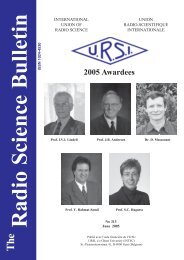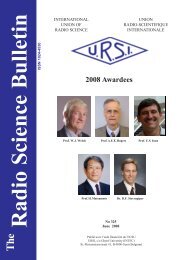December 2012 - URSI
December 2012 - URSI
December 2012 - URSI
Create successful ePaper yourself
Turn your PDF publications into a flip-book with our unique Google optimized e-Paper software.
RadioAstron: An Earth-Space<br />
Radio Interferometer with a<br />
350,000 km Baseline<br />
N.S. Kardashev<br />
Y.Y. Kovalev<br />
K.I. Kellermann<br />
Abstract<br />
RadioAstron is a Russian space-based radio telescope<br />
with a ten-meter dish, in a highly elliptical orbit with an<br />
eight-to-nine-day period. RadioAstron works together<br />
with Earth-based radio telescopes to give interferometer<br />
baselines extending up to 350,000 km, more than an order of<br />
magnitude improvement over what is possible from Earthbased<br />
very-long-baseline interferometry. Operating in four<br />
frequency bands corresponding to wavelengths of 1.3 cm,<br />
6 cm, 18 cm, and 92 cm, the corresponding resolutions are<br />
7, 35, 100, and 500 microarcseconds, respectively, in the<br />
four wavelength bands.<br />
1. Resolution of<br />
Radio Telescopes<br />
The first observations of cosmic radio emission in<br />
the 1930s by Karl Jansky [1-3], using a Bruce array only<br />
a few wavelengths across at a 15 m wavelength, had an<br />
angular resolution of a few tens of degrees. Later in the<br />
decade, Grote Reber [4] used a 32 ft parabolic dish at 2 m<br />
wavelength to improve the resolution to about 4°. The<br />
resolution of any instrument is limited by diffraction to an<br />
angle, , of the order of the wavelength of observation<br />
divided by the dimensions of the instrument. Because of<br />
this and the fact that radio wavelengths are longer than light<br />
5<br />
waves by a factor of 10 , for many years it was thought<br />
that the resolution of radio telescopes would always be<br />
limited compared with that of optical telescopes.<br />
However, for several reasons, it turns out that the<br />
reverse is true. First, due to their longer wavelength, it is<br />
much easier to build large diffraction-limited telescopes at<br />
radio wavelengths than at optical wavelengths, since the<br />
required mechanical tolerances are greatly relaxed at radio<br />
wavelengths. Second, at optical wavelengths, the path-length<br />
fluctuations in the Earth’s troposphere limit the resolution<br />
of optical observations by “seeing” to angles of the order<br />
of an arcsecond. Recent developments in adaptive optics<br />
using nearby stars or laser signals as a reference at infrared<br />
wavelengths are able to obtain resolutions somewhat better<br />
than 0.1 arcsec. The same is true for optical telescopes<br />
operating from space, such as the Hubble Space Telescope.<br />
However, at radio wavelengths, tropospheric path-length<br />
fluctuations are only comparable with the wavelength, and<br />
can easily be calibrated from observations of reference<br />
sources. For these reasons, the history of radio astronomy<br />
has been one of ever improving the angular resolution<br />
through a series of innovative technical developments.<br />
The largest fully steerable radio telescopes are those<br />
in Effelesberg, Germany, and in Green Bank, West Virginia<br />
in the USA, each with an effective diameter of 100 m.<br />
Variations in mechanical tolerances due to wind, temperature<br />
variations across the structures, and the effects of gravity<br />
as the structures are moved limit operation to wavelengths<br />
as short as about 1 cm. This gives an angular resolution of<br />
about 30 arcsec.<br />
2. Radio Interferometry<br />
Unlike light waves, radio signals from one part of the<br />
telescope can be amplified, split, and compared coherently<br />
with signals from other parts of the instrument. Starting in<br />
the 1940s, radio astronomers began to use widely spaced<br />
interferometers of modest-size parabolic-antenna elements<br />
to give resolutions determined by the interferometer spacing,<br />
and not by the dimensions of the individual antennas. Since<br />
each interferometer pair measures one Fourier component of<br />
the brightness distribution of the radio source, observations<br />
with multiple element arrays are used to reconstruct the<br />
two-dimensional radio-source structures [5]. In the typical<br />
radio interferometer or array, a common local-oscillator<br />
signal is sent to each of the distant elements, where it is used<br />
N. S. Kardashev and Y. Y. Kovalev are with the Astro Space<br />
Center of the P. N. Lebedev Physical Institute, Moscow,<br />
Russia; Tel: +7 495 333 2167 (YYK); e-mail: nkardash@<br />
asc.rssi.ru; yyk@asc.rssi.ru. K. I. Kellermann is with the<br />
National Radio Astronomy Observatory, 520 Edgemont Rd.,<br />
Charlottesville, VA, 22901, USA; Tel: +1 434 296 0240;<br />
e-mail: kkellerm@nrao.edu.<br />
This paper is one of the invited Reviews of Radio Science<br />
from Commission J<br />
22 The Radio Science Bulletin No 343 (<strong>December</strong> <strong>2012</strong>)
















